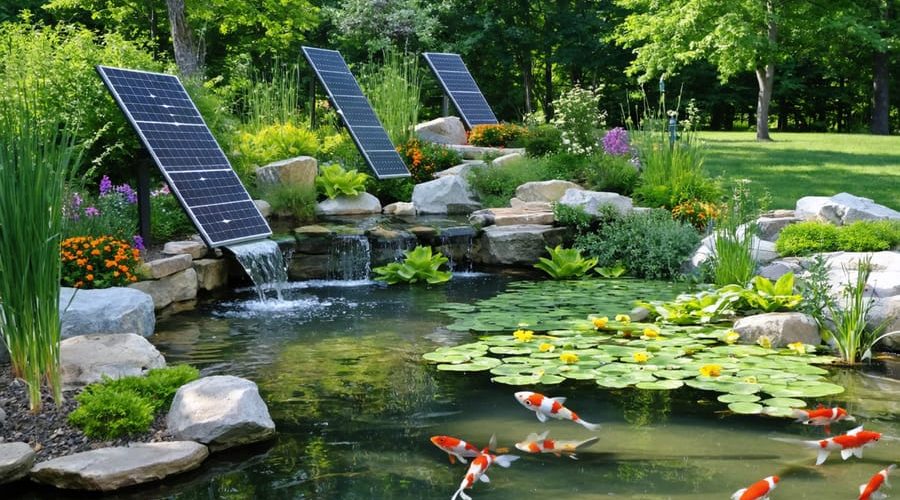
Build Your Dream Ecosystem Pond With These Sustainable DIY Solutions
Transform your backyard into a thriving self-sustaining pond ecosystem that balances nature’s elements perfectly. Creating a DIY ecosystem pond combines the artistry of landscaping with the science of natural water systems, offering a sustainable haven for wildlife while requiring minimal maintenance. Unlike traditional water features that depend heavily on artificial filtration, ecosystem ponds harness beneficial bacteria, aquatic plants, and natural biological processes to maintain crystal-clear water. By incorporating essential elements like bottom drains, skimmers, and strategic plant zones, you’ll establish a living system that largely maintains itself, creating a magnificent focal point that enriches your outdoor space with the soothing sounds of flowing water and the vibrant activity of pond life. Whether you’re a seasoned DIY enthusiast or a first-time pond builder, understanding the fundamental principles of ecosystem balance will empower you to create a water feature that thrives year after year.
Natural Filtration: The Heart of a Sustainable Pond
Biological Filtration Zones
A healthy ecosystem pond relies heavily on biological filtration zones, which act as nature’s own cleaning crew. These areas use a combination of beneficial bacteria and specific plants to break down waste and maintain crystal-clear water naturally.
Start by creating a shallow shelf around the pond’s edge, about 6-12 inches deep. This area, known as the marginal zone, is perfect for plants like cattails, iris, and rushes. These plants not only look beautiful but also absorb excess nutrients that could otherwise feed unwanted algae.
In deeper areas, typically 18-24 inches, establish a bog zone using gravel or lava rock. This creates an ideal home for beneficial bacteria, which break down fish waste and organic matter. Adding plants like water lilies and submerged oxygenators in this zone helps maintain oxygen levels and provides additional filtration.
Consider incorporating a dedicated wetland filter at the pond’s highest point. This separate area, filled with gravel and planted with moisture-loving plants, acts as a natural filter as water flows through it. The plant roots and gravel create an enormous surface area for beneficial bacteria to colonize.
Remember to position these filtration zones where water naturally flows through them. This ensures maximum contact time between the water and your biological filtering system, resulting in cleaner, healthier pond water without the need for excessive chemical treatments.
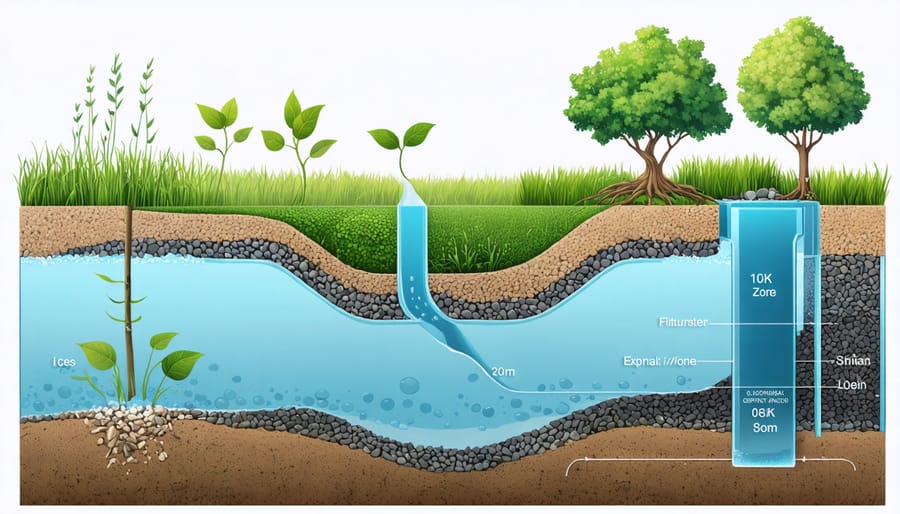
Energy-Efficient Pump Systems
Choosing the right energy-efficient pump systems is crucial for maintaining a healthy ecosystem pond while keeping electricity costs down. Solar-powered pumps have become increasingly popular among DIY pond enthusiasts, offering an eco-friendly solution that can significantly reduce your energy bills. These systems work best in areas with plenty of direct sunlight and can be paired with battery backup systems for cloudy days.
For those who prefer traditional electric pumps, many manufacturers now offer energy-smart options that adjust their power consumption based on water flow needs. Look for pumps with variable speed settings and those labeled with Energy Star certification. A properly sized pump should circulate your entire pond volume once every two hours, but you don’t need maximum power all the time.
Consider installing a timer to reduce pump operation during nighttime hours when oxygen demands are lower. Many modern pumps also feature “eco modes” that can cut energy usage by up to 50% during off-peak times. For smaller ponds under 1,000 gallons, magnetic drive pumps are excellent choices as they use less electricity while providing reliable performance.
Remember that regular maintenance of your pump system, including cleaning the intake screen and checking for debris buildup, will help maintain optimal efficiency and extend the life of your equipment. This preventive care ensures your pump operates at peak performance while consuming minimal energy.
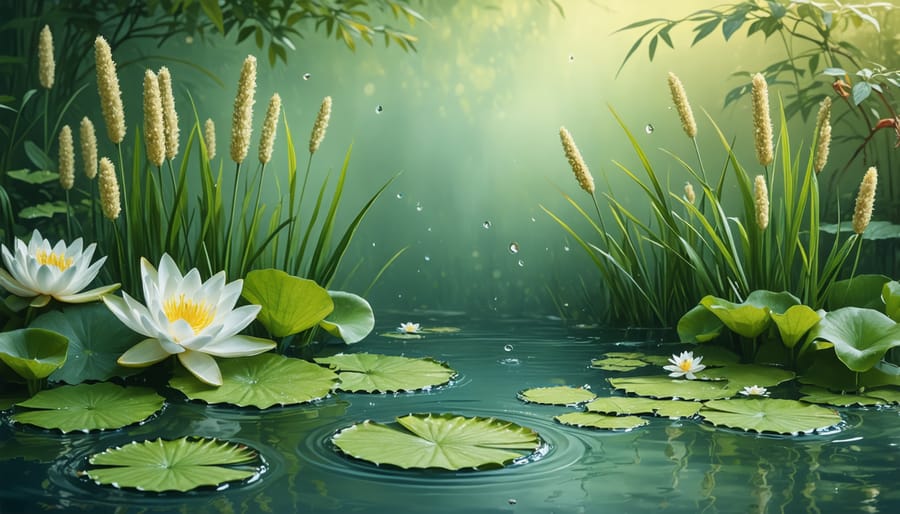
Smart Plant Selection for Self-Sustaining Balance
Oxygenating Plants
Oxygenating plants are essential aquatic plants that work like underwater air filters, keeping your pond water clean and healthy. These submerged plants release oxygen during the day and absorb excess nutrients that could otherwise feed unwanted algae.
Popular choices include Hornwort, which grows quickly and adapts well to various conditions, and Elodea (also known as Waterweed), which remains green year-round. Water Milfoil is another excellent option, providing shelter for beneficial microorganisms while helping maintain crystal-clear water.
For best results, aim to cover about 50-60% of your pond’s surface area with oxygenating plants. Plant them in small bunches, anchored in pots with aquatic soil or gravel. Don’t worry if they seem sparse at first – these plants multiply naturally over time. During spring and summer, they’ll work overtime to keep your pond balanced, though you might need to thin them out occasionally to prevent overcrowding.
Remember to place these plants in areas where they’ll receive adequate sunlight but won’t interfere with your pond’s pump or filter system.
Marginal and Floating Plants
Marginal and floating plants are essential components of a thriving ecosystem pond, creating natural beauty while supporting the pond’s ecological balance. These plants can be divided into two main categories, each serving unique purposes in your water garden.
Marginal plants grow along the pond’s edges and shallow shelves, helping to blend your pond naturally into the surrounding landscape. Popular marginal choices include iris, rushes, and cattails, which provide valuable shelter for wildlife and help prevent algae growth by shading the water. Plant these in submerged containers filled with aquatic soil, positioning them on shelves or ledges where the water depth ranges from 2 to 12 inches.
Floating plants, such as water lilies and lotus, add stunning visual interest while providing essential shade for fish and helping to maintain cooler water temperatures. Their leaves cover roughly 50-70% of the water’s surface, naturally limiting algae growth by reducing sunlight penetration. Water lettuce and duckweed are excellent free-floating options that help absorb excess nutrients from the water.
When selecting plants, consider your climate zone and pond depth. Start with a mix of 3-4 different species and observe how they develop. Some aggressive growers like cattails might need regular trimming to prevent overtaking the pond. For best results, plant in spring when water temperatures are warming up.
Both types of plants contribute to natural filtration by absorbing nitrates and other nutrients that would otherwise feed algae. They also provide spawning areas for fish and shelter for beneficial insects and amphibians. During winter, trim back dead foliage to prevent excess organic matter from decomposing in the water.
Remember to avoid invasive species that could spread to natural waterways. Check local regulations regarding restricted aquatic plants in your area before making your final selections.
DIY Construction Methods
Sustainable Materials Selection
When building your ecosystem pond, choosing eco-friendly materials isn’t just good for the environment – it creates a healthier habitat for your aquatic life. Start with an EPDM rubber liner, which is both durable and non-toxic to fish and plants. This material typically lasts 20+ years and can be recycled at the end of its life.
For edging and decorative elements, opt for local natural stone rather than manufactured materials. This reduces transportation emissions and helps your pond blend seamlessly with the surrounding landscape. Avoid pressure-treated lumber near the water, as it can leach chemicals. Instead, use cedar or cypress for any wooden structures – these naturally resist decay without harmful treatments.
Consider recycled materials where possible. Many landscaping suppliers now offer recycled glass aggregate for drainage layers, and reclaimed stones make excellent features around the pond’s edge. For planting shelves and biological filtration zones, use clay-based aquatic soil rather than regular garden soil or artificial substrates.
For your underlayment (the protective layer beneath the liner), choose recycled geotextile fabric instead of new materials. When selecting rocks for the bottom of your pond, wash river rock is ideal – it’s smooth, natural, and provides beneficial bacteria with plenty of surface area to colonize.
Remember to source materials locally whenever possible to reduce your project’s carbon footprint. Many suppliers now specialize in sustainable pond materials, so don’t hesitate to ask about eco-friendly options.
Natural Edge Construction
The natural edge of your ecosystem pond plays a crucial role in both aesthetics and functionality. To create wildlife-friendly edges, start by gently sloping the sides at varying angles. This gradual transition from land to water mimics natural ponds and provides safe access for wildlife.
Layer different-sized rocks along the edges, starting with larger boulders at the bottom and working up to smaller stones. Tuck plants between rocks to soften the appearance and create hiding spots for small creatures. Allow some stones to extend slightly over the water, creating basking spots for frogs and turtles.
Include shallow shelves at different depths around the edge. These stepping zones, ranging from 2 to 6 inches deep, support marginal plants and give birds safe places to drink and bathe. Leave small gaps between stones where beneficial insects can find shelter.
For a more natural look, bring the surrounding landscape right up to the pond’s edge. Plant native grasses and perennials that will naturally drape over the rocks. This not only looks beautiful but also helps blend the pond seamlessly into your garden. Remember to slightly overhang the pond liner at the edges and cover it completely with soil and plants to hide any artificial materials from view.
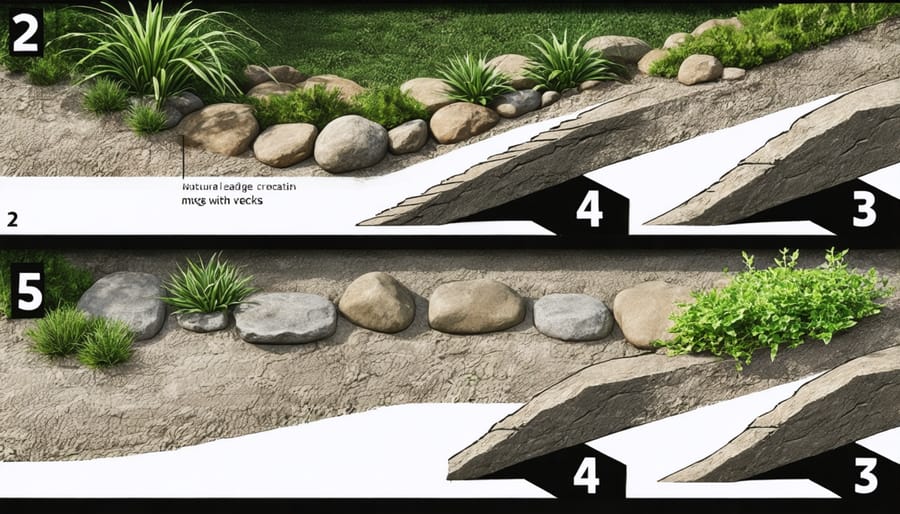
Water Conservation Features
Conserving water in your ecosystem pond isn’t just environmentally responsible – it’s also budget-friendly! Start by installing an automatic water level controller (auto-fill valve) that maintains the optimal water level without wasteful overflow. This simple device connects to your home’s water supply and activates only when needed.
To minimize evaporation, consider adding floating plants like water lilies that provide natural shade. Installing a pond cover for extremely hot days can also help reduce water loss. Strategic placement of your pond in a partially shaded area further reduces evaporation while maintaining healthy water temperatures.
Make the most of natural rainfall by creating a catchment system. Install drainage channels or rain gutters that direct rainwater into your pond. You can also build a rain garden nearby that filters and slowly releases collected water into your pond system. Remember to angle your pond’s edges slightly inward to prevent water loss from overflow during heavy rains.
Consider using a bottom drain system with a settlement chamber. This setup helps reduce water waste during cleaning by allowing you to remove settled debris without draining the pond. A properly sized skimmer box also helps maintain water quality while minimizing the need for frequent water changes.
For areas prone to leaks, use high-quality EPDM rubber liner and pay special attention to sealing around pipes and features. Regular maintenance checks for leaks and prompt repairs will ensure your pond remains water-efficient year-round.
Maintenance and Monitoring
Natural Cleaning Methods
Keeping your ecosystem pond clean doesn’t require harsh chemicals. Nature provides everything you need for crystal-clear water! Start by incorporating plenty of aquatic plants – they’re your first line of defense against excess nutrients and algae. Water lilies, cattails, and floating plants like duckweed work together to absorb nitrates and phosphates while providing shade that limits algae growth.
Beneficial bacteria are your underwater cleanup crew. These microscopic helpers break down organic matter and help maintain the nitrogen cycle. You can boost their population by adding substrate like lava rock or gravel, giving them plenty of surface area to colonize.
For natural filtration, create a bog filter using gravel and marsh plants. Water passing through this area gets cleaned by both plant roots and beneficial bacteria. Adding barley straw to your pond can also help inhibit algae growth naturally.
Fish play their part too! Bottom feeders like koi and goldfish help stir up debris that can then be caught by your filter system. Just remember to maintain the right fish-to-water ratio to prevent overloading your pond’s natural cleaning capacity.
Regular skimming of fallen leaves and occasional trimming of dead plant matter will support these natural processes. By working with nature rather than against it, your pond will develop a healthy, self-sustaining balance that keeps the water naturally clear and clean.
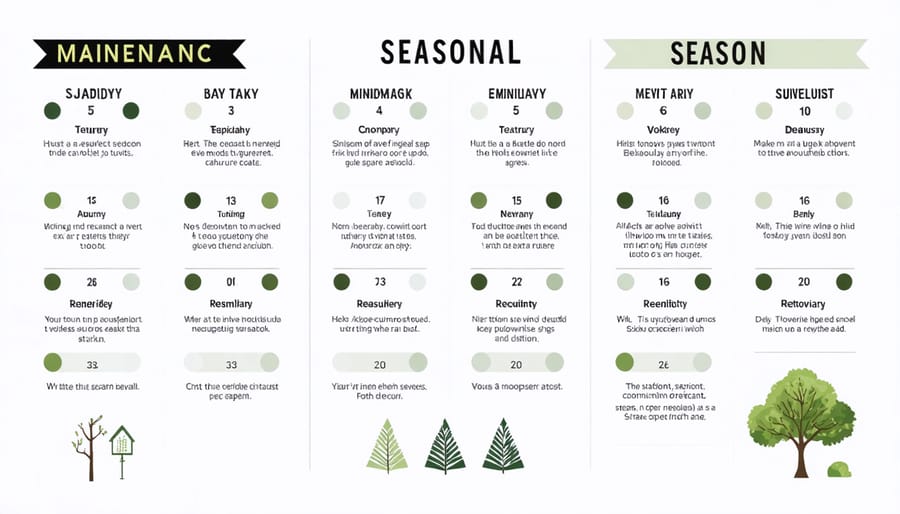
Seasonal Care Tips
Keeping your ecosystem pond thriving requires attention to seasonal changes and timely maintenance. In spring, focus on cleaning debris and preparing your pond for new growth. Remove dead plant material, check your pump, and gradually reintroduce beneficial bacteria as temperatures rise. Consider these essential pond maintenance tips to ensure a healthy transition.
Summer calls for regular monitoring of water levels and quality. Top up your pond during dry spells, trim plants to prevent overgrowth, and maintain adequate aeration. Keep an eye on algae growth and adjust your plant coverage to provide 60-70% surface shade.
As autumn approaches, install netting above your pond to catch falling leaves. Reduce feeding as temperatures drop and remove dying plant material before it can decompose in the water. Trim back marginal plants and remove tropical species that won’t survive winter.
Winter maintenance is minimal but crucial. Keep a small hole in the ice for gas exchange if your pond freezes over – never break the ice directly as this can harm your fish. Use a floating de-icer if necessary, and avoid disturbing hibernating fish. Remove snow from ice to allow light penetration for underwater plants.
Remember to check your filtration system monthly throughout the year and maintain consistent beneficial bacteria levels for a balanced ecosystem.
Creating your own ecosystem pond is a rewarding journey that brings nature’s beauty right to your backyard. By following the principles we’ve discussed – from proper design and construction to selecting the right combination of plants and fish – you can establish a thriving, self-sustaining water feature that requires minimal maintenance.
Remember that success lies in maintaining the delicate balance between all elements of your pond ecosystem. The natural filtration system, supported by beneficial bacteria, aquatic plants, and proper circulation, works together to keep your water crystal clear. Your careful selection of native plants not only adds visual appeal but also provides essential functions like water purification and wildlife habitat.
As you embark on your pond-building adventure, take time to plan carefully and consider the long-term sustainability of your choices. Start small if you’re new to water gardening, and don’t be afraid to adjust your design as you learn more about your pond’s unique characteristics.
The true beauty of an ecosystem pond lies in its ability to evolve and mature over time. With patience and proper care, your DIY pond will become a vibrant sanctuary for local wildlife, a peaceful retreat for your family, and a testament to the possibilities of working with nature rather than against it.
Remember, every ecosystem pond is unique, and part of the joy is watching your creation develop its own personality as it becomes an integral part of your landscape.
